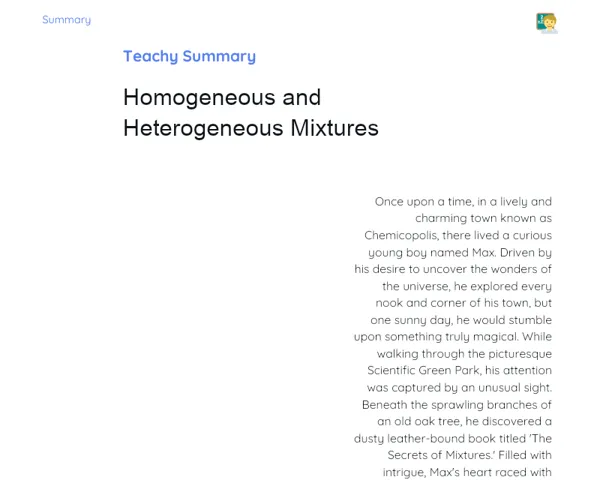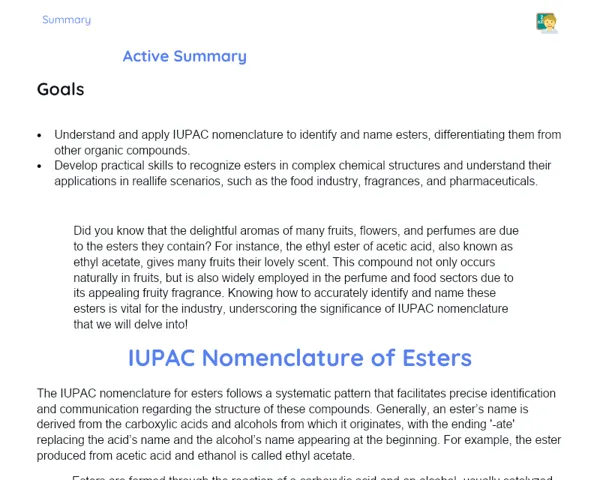Socioemotional Summary Conclusion
Goals
1. 🌟 Differentiate the types of chemical reactions: addition, decomposition, single exchange, and double exchange.
2. 🔍 Identify the reactants and products in various chemical reactions.
Contextualization
💡 Have you ever wondered how your mobile works or how our body breaks down food? All this happens because of chemical reactions! By understanding addition, decomposition, single exchange, and double exchange reactions, we can unlock the many mysteries happening around us every day. Are you ready to explore how chemistry influences even the smallest details of our lives? 🚀
Exercising Your Knowledge
Addition Reactions
🌟 Addition reactions happen when two or more reactants come together to form a single product. Think of it like joining two pieces of jigsaw puzzle; they combine to create a new picture! In addition reactions, reactants unite to form something entirely new. This type of reaction is foundational in numerous industries and biological processes.
-
🔍 Definition: A reaction in which two or more reactants combine to create one product. For example: A + B → AB.
-
⚗️ Real Example: Adding hydrogen to ethene to create ethane: C₂H₄ + H₂ → C₂H₆.
-
🌍 Practical Application: Addition reactions are key in the making of many chemicals and medicines we utilize every day.
Decomposition Reactions
✨ Decomposition reactions involve a single reactant breaking down into two or more products. Just like taking apart a piece of furniture to see how it's constructed, these reactions reveal the initial makeup of complex substances. They play an essential role in processes like digestion in our bodies.
-
🧩 Definition: A reaction where one reactant decomposes into multiple products. Example: AB → A + B.
-
🔥 Real Example: The breakdown of calcium carbonate when heated: CaCO₃ → CaO + CO₂.
-
🌐 Practical Application: These reactions are crucial in the industry for breaking down compounds, especially in waste management.
Single Exchange Reactions
⚡️ In single exchange reactions, an element reacts with a compound, displacing another element from that compound, almost like a dance partner swapping places! This type of reaction is vital for understanding corrosion and many biological processes.
-
🔁 Definition: A reaction where one element replaces another in a compound. Example: A + BC → AC + B.
-
📚 Real Example: The reaction of zinc with hydrochloric acid: Zn + 2HCl → ZnCl₂ + H₂.
-
🔍 Practical Application: These reactions are significant in electroplating and manufacturing metal products.
Double Exchange Reactions
🔄 Double exchange reactions consist of two compounds swapping ions to create two new compounds. Picture two couples switching partners! These reactions are widely utilized in analytical chemistry and water treatment.
-
🔗 Definition: A reaction where two compounds exchange ions to form new compounds. Example: AB + CD → AD + CB.
-
💧 Real Example: The reaction between sodium chloride and silver nitrate: NaCl + AgNO₃ → NaNO₃ + AgCl.
-
🏭 Practical Application: Commonly used in water purification and in detecting ions in lab settings.
Key Terms
-
💡 Reactants: Substances that initiate the chemical reaction.
-
🌟 Products: Substances generated as a result of the chemical reaction.
-
🧪 Chemical Equation: A symbolic representation indicating the reactants and products of a chemical reaction.
-
🔄 Addition Reaction: A reaction where multiple reactants combine to yield one product.
-
🔀 Single Exchange Reaction: A reaction where one element substitutes another in a compound.
-
♻️ Double Exchange Reaction: A reaction involving the exchange of ions between two compounds to produce new compounds.
-
⚗️ Decomposition Reaction: A reaction where a single reactant breaks down into two or more products.
For Reflection
-
🤔 How can you connect your emotions while collaborating with peers to the chemical reactions unfolding around us?
-
📝 Reflect on a challenging situation you encountered recently. How did you apply (or could have applied) emotional regulation techniques to navigate that scenario?
-
🌟 In what ways can your understanding of chemical reactions assist you in making more informed and responsible choices in everyday life?
Important Conclusions
-
🔬 We differentiated and understood four main types of chemical reactions: addition, decomposition, single exchange, and double exchange.
-
🧪 We learned to recognize the reactants and products across various reactions, which is essential for any chemical assessment.
-
💡 We uncovered the significance of chemical reactions in our daily lives and how they connect to key biological and industrial processes.
-
🌍 We realised that beyond chemical reactions, socio-emotional skills are integral to our personal and academic growth.
Impacts on Society
Chemical reactions have a substantial influence on our society. For instance, the development of life-saving medications directly stems from an understanding of addition and decomposition reactions. In the industrial realm, single and double exchange reactions are pivotal in the creation of materials we rely on every day, including plastics, metals, and the clean drinking water we need. These reactions facilitate the technological advancements that shape our modern lifestyles. 🌐 On a personal level, understanding chemical reactions helps us make better decisions, such as opting for sustainable and healthy products by being aware of their chemical effects on our environment and health. Moreover, knowledge of chemical reactions equips us to remain composed and devise creative solutions to challenges through structured and analytical reasoning, enhancing our resilience and boosting our confidence.
Dealing with Emotions
Let's engage in an exercise to manage emotions while studying chemical reactions! First, Recognize how you feel when grappling with difficult topics. It could range from frustration to eagerness! Next, Understand the reason behind your feelings: is it the newness of the topic, or is the content too complex? Then, Name these emotions — figure out if it's anxiety or excitement. Express your feelings appropriately: share them with a peer or pen down your frustrations and victories in a journal. Finally, Regulate your emotions by practicing deep breathing or meditation techniques to stay calm and focused. 🧘♂️🧘♀️
Study Tips
-
📝 Create Mind Maps: Visually categorize chemical reactions with mind maps for clearer understanding and connections.
-
📚 Summarize: Prepare concise summaries of key chemical reactions and their characteristics, using relatable examples to enhance comprehension.
-
👥 Collaborate in Groups: Engaging with friends and colleagues can clarify doubts and help solidify your understanding of the material collectively.


